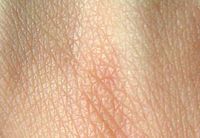
Photo from wikipedia
Abstract An effective ratiometric fluorescence resonance energy transfer (FRET) assay developed for the sensitive and specific measurement of microRNAs-21 (miRNA-21) using graphdiyne quantum dots (GDQDs) as the new fluorescent probe.… Click to show full abstract
Abstract An effective ratiometric fluorescence resonance energy transfer (FRET) assay developed for the sensitive and specific measurement of microRNAs-21 (miRNA-21) using graphdiyne quantum dots (GDQDs) as the new fluorescent probe. GDQDs with uniform size, narrow defined tunable emission peak and good crystallization synthesized via a classical solvothermal approach. In the sensing strategy, GDQDs modified with DNA probe exhibited strong fluorescence (FL) signal at 405 nm, while in the presence of graphene quantum dots (GQDs) duo to Forster-resonance-energy transfer process between GDQDs and GQDs, the fluorescence of GDQDs was efficiently quenched, meanwhile, a new fluorescence signal at 505 nm for GQDs provided. In the presence of miRNA-21, with the hybridization between miRNA-21 and GDQDs modified with DNA probe, the distance of GDQDs (donor) and GQD (acceptor) is increased, and the intensity fluorescent signal of GDQD recovered, which confirmed by decreasing of the average life times for GDQDs-DNA probe from 1.99 to 0.61ns after addition of GQDs, while the average life time increased again to 1.26 ns in the presence of micRNA-21 target. The ratio of the FL intensity (F405/F505) behaved precise and sensitive analytical efficiency for miRNA-21 detection with a good linear range from 5 pM to 200 nM and a detection limit of 0.5 pM (S/N = 3). More importantly, this RNA sensor was feasible to detect target microRNA-21 in the human serum sample and MCF-7 cell lines with a detection limit of 4 cells/10 μL. Furthermore, due to low cytotoxicity of GDQDs multicolour imaging of MDA-MB231 living cancer cells also utilized.
Journal Title: Journal of Luminescence
Year Published: 2021
Link to full text (if available)
Share on Social Media: Sign Up to like & get
recommendations!